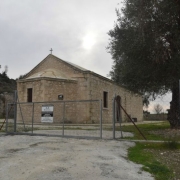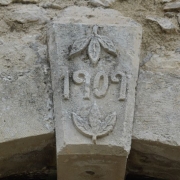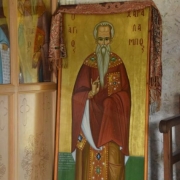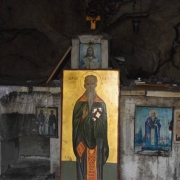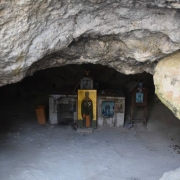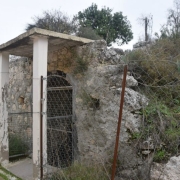It is a single-aisle, vaulted church with a rectangular plan with a hipped roof and a three-sided apse, which bears a rectangular window in the center. The apse is crowned with a simple cornice, which bears carved stone gutters at the corners for rainwater drainage. The church is built with adobe masonry, except for its corners, where carved local stone was used.
The church’s arch is pointed and internally supported by two concrete arches and corresponding counter-ridges, which are externally visible only on the south side. Its main entrance is on the north side, while a second one is also on the west. On the west side there is a wide semicircular arch, which was walled up and opened in parallel with the west doorway of the church. The frames of the entrances and windows are made of limestone. The date 1909 is engraved on the keystone of the stone door of the northern entrance, which indicates the year the church was built. At first glance, there is no evidence of an earlier church.
The wooden carved throne and shrine from the church of Panagia Chryseleousa in Lysos, works of the 18th century, have been transferred to the church. In the 1940s, the vemothyra, the Crucifix and the Lypira of the church of Agios Merkurios were transferred to the church. The lintel of the church of Agios Merkurios is currently kept in the Diocese of Arsinoe.
In the northeast corner of the north side there is a walled-in inscription in second use: “BUILT / AT OWN / EXPENSES / BY THE SUPERINTENDENT / OF CHAIRMAN CH. DAMALIS / FROM LYSSOS / AND OF THE SUPERINTENDENT (sic) / OF THE ARCHITECT (sic) CYRRIS / FROM LAPITHUS”. According to personal testimony, this inscription was originally located at the fountain of Lysos.
To the south of the church is the entrance to an underground natural cave, which is approximately 6 meters wide and 4 meters deep. In the center of the cave there is a modern concrete shrine, which according to testimony occasionally served as a Holy Altar for holding services. On its SE side there are two or three carved recesses in the form of unfinished arcosoliums, which would probably attest to the use of the cave for burial purposes. It is possible that the cave had also served as a hermitage for hermits, to which a temple was subsequently attached due to the honor attributed to the place. The systematic cleaning of the cave would certainly reveal much about its use and history.
Saint Charalambos is considered by the villagers of the surrounding villages, both Christian and Muslim, to be the protector of their flocks. When the animals fell ill, they would take white clay from the cave and holy water, which gushed out near the temple, and sprinkle it on their animals, in order to cure them.
Before 1963, on February 10, a large livestock fair was held in the courtyard and surrounding area of the church of Saint Charalambos.


